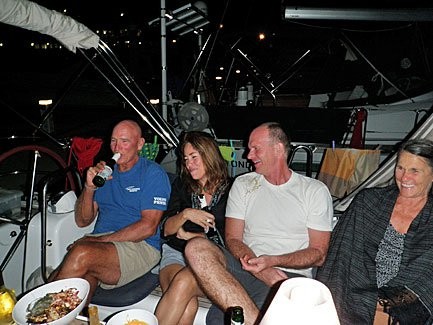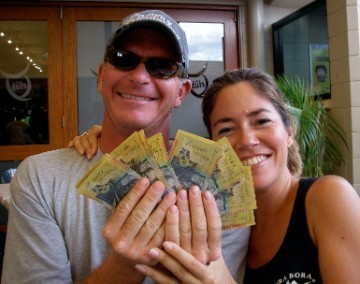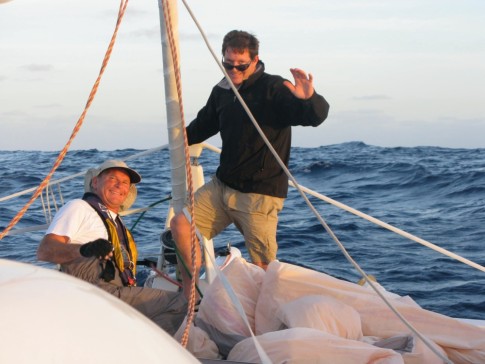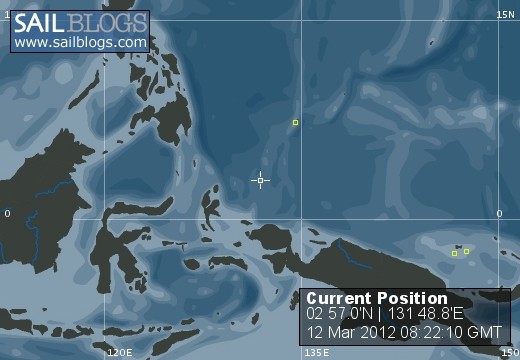
Endless Summer
Endless Summer is a 43ft Ian Farrier cruising catamaran.
27 July 2011 | 11 07'S:152 19'E, Louisiade Achipelago
26 July 2011 | Duchateau Islands, Louisiades Archipelago, PNG
25 July 2011 | 11 17'S:152 20'E, Louisiade Achipelago
23 July 2011 | Herald Cay
23 July 2011 | 16 56'S:149 11'E, Coral Sea
23 July 2011 | Herald Cay
20 July 2011 | 19 27'S:148 39'E, Great Barier Reef
20 July 2011 | Great Barrier Reef, Australia
16 July 2011 | Bismarck Sea
25 June 2011 | Great Barrier Reef, Australia
25 June 2011 | Whitsunday Islands
24 June 2011 | Whitsunday Islands, Australia
13 June 2011 | Great Barrier Reef, Australia
10 June 2011 | The Whitsunday Islands, Australia
28 May 2011 | off Bowen, Queensland
17 May 2011 | 20 17'S:148 57'E, Australia
13 May 2011 | Sydney
12 May 2011 | 27 51'S:153 21'E, Australia
13 December 2010 | Tahiti
09 December 2010 | Tanna Island, Vanuatu
Showdown at Helen Reef Part 2 of 2
12 March 2012 | Helen Reef
Steve
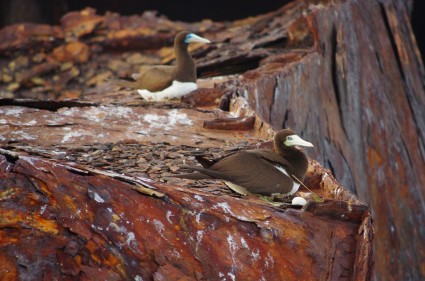
So today as the rangers came down to the pass to wish us farewell, and found their atoll invaded by three Phillipino fishing boats with 25 or 30 men on each, Max put his wife Matty aboard Endless Summer and asked us to stand by while he and another ranger went to politely ask the boats to leave.
It took half an hour for them to reach the first boat, and then an hour to reach the second and get back to Endless Summer. The boats were willing to leave, but took their sweet time. As they slowly moved toward the pass out of the atoll their little launches buzzed around continuing to fish all the way out.
When Max and David returned to Endless Summer he indicated that the fishermen seemed to be more concerned with our presence than the rangers. It seems that the last two times that fishing boats had been caught by the Palauan patrol boat, a cruising boat had happened to be at Helen Reef. So the association was made.
It was approaching two in the afternoon when the last boat finally meandered past Endless Summer and out of the reef pass. The rangers had departed back to their island to use the radio to call the main office 300 miles north on the main island of Palau. If the fishing boats were still there in the morning, they were told, the patrol boat would come. The patrol boat is a large, (100 foot) cutter provided by the Australian government to patrol Palauan waters for illegal fishing. It can make the 300 mile trip to Helen in about 10 hours. If the fishing boats were to be caught in Palauan waters, they would be arrested and towed back to Palau. Unfortunately because of corrupt individuals in Palau’s government who receive a financial benefit from the illegal fishing, the boats would most likely be sold back to the original owners at a steep discount. In other countries like Australia for example, the boats would be burned and the crew deported. If possible the companies involved would face steep fines.
So with all of this in mind I was furious to see that no sooner had the mother ships departed the atoll and headed south, that they had re-deployed their fleet. The little skiffs had just come back in across the reef at the south end. So with a little concern that the fisherman were armed, but wishing I could do something to stop the destruction of the atoll, I aimed Endless Summer at the ragtag fleet and piled on as much sail as I could. I was delighted, and relieved to hear the apologetic tone of the fisherman, and so tried to sound as much like the commander of a U.S. aircraft carrier as I could and ordered the fisherman to withdraw.
And so it goes the world over. Wildlife reserves, no-take zones, conservation areas of all kinds are pilfered because of lack of enforcement. Of course there are many other complex elements to the problem. The fisherman on those boats are “just trying to feed their families.” The consumers continue to demand shark fin soup, and other highly endangered species like blue fin tuna, (ahi) on their menus.
We should know the results of all of this in about 50 years. Either we will recognize the connection between the way we live and the effect it has on our environment, or the oceans will collapse and humans will face mass starvation. Not everyone will die, but most people probably will.
It took half an hour for them to reach the first boat, and then an hour to reach the second and get back to Endless Summer. The boats were willing to leave, but took their sweet time. As they slowly moved toward the pass out of the atoll their little launches buzzed around continuing to fish all the way out.
When Max and David returned to Endless Summer he indicated that the fishermen seemed to be more concerned with our presence than the rangers. It seems that the last two times that fishing boats had been caught by the Palauan patrol boat, a cruising boat had happened to be at Helen Reef. So the association was made.
It was approaching two in the afternoon when the last boat finally meandered past Endless Summer and out of the reef pass. The rangers had departed back to their island to use the radio to call the main office 300 miles north on the main island of Palau. If the fishing boats were still there in the morning, they were told, the patrol boat would come. The patrol boat is a large, (100 foot) cutter provided by the Australian government to patrol Palauan waters for illegal fishing. It can make the 300 mile trip to Helen in about 10 hours. If the fishing boats were to be caught in Palauan waters, they would be arrested and towed back to Palau. Unfortunately because of corrupt individuals in Palau’s government who receive a financial benefit from the illegal fishing, the boats would most likely be sold back to the original owners at a steep discount. In other countries like Australia for example, the boats would be burned and the crew deported. If possible the companies involved would face steep fines.
So with all of this in mind I was furious to see that no sooner had the mother ships departed the atoll and headed south, that they had re-deployed their fleet. The little skiffs had just come back in across the reef at the south end. So with a little concern that the fisherman were armed, but wishing I could do something to stop the destruction of the atoll, I aimed Endless Summer at the ragtag fleet and piled on as much sail as I could. I was delighted, and relieved to hear the apologetic tone of the fisherman, and so tried to sound as much like the commander of a U.S. aircraft carrier as I could and ordered the fisherman to withdraw.
And so it goes the world over. Wildlife reserves, no-take zones, conservation areas of all kinds are pilfered because of lack of enforcement. Of course there are many other complex elements to the problem. The fisherman on those boats are “just trying to feed their families.” The consumers continue to demand shark fin soup, and other highly endangered species like blue fin tuna, (ahi) on their menus.
We should know the results of all of this in about 50 years. Either we will recognize the connection between the way we live and the effect it has on our environment, or the oceans will collapse and humans will face mass starvation. Not everyone will die, but most people probably will.
Showdown at Helen Reef Part 1 of 2
12 March 2012 | Helen Reef
Steve
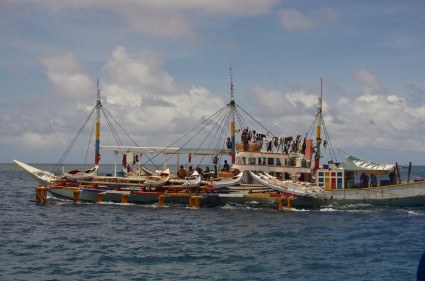
We sailed fast, straight toward the three Philippino fishing boats. We were in the calm water just outside the reef and with the wind from a small rain squall we were hitting speeds of 10 knots. The three boats tried to steer out of our way, but I adjusted course and continued to run on a collision course. It was a sort of environmental road rage. I wanted to run those boats down and cut them in half. At that moment I wished that Endless Summer was a steel hulled boat rather than foam and epoxy.
Then the radio crackled, “sailing boat, sailing boat.” “This is the fishing boat calling.” “I am very sorry, very sorry.” “We went inside the reef because of the bad weather last night.” “I am very sorry, I apologize.”
I was surprised at myself for the force of my response, “This is the United States flagged sailing vessel Endless Summer!” “You are in violation of international law.” “This is a conservation area.” I demand that you withdraw your fleet immediately.” The captain of the fishing boat tried again to apologize and give a weak excuse for his blatant and deliberate fishing expedition into Helen Reef, the southern most and largest Palauan conservation area. I threatened again that the Palauan patrol boat was on its way and that he must withdraw his fishing fleet. Then I altered course and we sailed south for Indonesia.
Manjula and I had spent almost a week anchored in Helen Reef, a 10 mile long atoll with a tiny sliver of an island near the north end. The reef is a conservation area and is strictly off limits to fishing of any kind. These areas are essential if there is to be any hope of restoring the health and vitality of the world’s oceans.
We were on our way out of the atoll bound for Indonesia when we saw the three fishing boats. Two were inside the large lagoon several miles away from us. One boat was outside. This kind of fishing boat is unusual for the western eye. It is comprised of a long narrow hull about 60 feet long, with outriggers built out on either side. The craft looks something like a raft with laundry hanging from lines strung between bamboo poles and smoke streaming up from mysterious bubbling kettles somewhere near the stern section. These are the mother ships. Each one is equipped with 10 or 15 small launches that are shaped much like one of Sinbad the Sailor’s shoes. They are just big enough to fit two men. These launches do the fishing and bring their catch back to the mother boat for processing while they continue to fish.
Today, there were a dozen or more of these small launches working the reef. They were harvesting sea cucumbers, and anything else they could catch, including sharks. They don’t want the sharks for meat, just the fins. The shark is thrown back in to drown after all its fins are cut off.
Helen Reef has a resident ranger team primarily to tag green sea turtles, but also to patrol the large atoll for illegal fishing. But the rangers are only three men and one woman. They are unarmed, and the fishing boats are usually armed. In the past there have been kidnapping attempts, weapons drawn, and various other scary happenings when the fishermen have been confronted and chased out.
Then the radio crackled, “sailing boat, sailing boat.” “This is the fishing boat calling.” “I am very sorry, very sorry.” “We went inside the reef because of the bad weather last night.” “I am very sorry, I apologize.”
I was surprised at myself for the force of my response, “This is the United States flagged sailing vessel Endless Summer!” “You are in violation of international law.” “This is a conservation area.” I demand that you withdraw your fleet immediately.” The captain of the fishing boat tried again to apologize and give a weak excuse for his blatant and deliberate fishing expedition into Helen Reef, the southern most and largest Palauan conservation area. I threatened again that the Palauan patrol boat was on its way and that he must withdraw his fishing fleet. Then I altered course and we sailed south for Indonesia.
Manjula and I had spent almost a week anchored in Helen Reef, a 10 mile long atoll with a tiny sliver of an island near the north end. The reef is a conservation area and is strictly off limits to fishing of any kind. These areas are essential if there is to be any hope of restoring the health and vitality of the world’s oceans.
We were on our way out of the atoll bound for Indonesia when we saw the three fishing boats. Two were inside the large lagoon several miles away from us. One boat was outside. This kind of fishing boat is unusual for the western eye. It is comprised of a long narrow hull about 60 feet long, with outriggers built out on either side. The craft looks something like a raft with laundry hanging from lines strung between bamboo poles and smoke streaming up from mysterious bubbling kettles somewhere near the stern section. These are the mother ships. Each one is equipped with 10 or 15 small launches that are shaped much like one of Sinbad the Sailor’s shoes. They are just big enough to fit two men. These launches do the fishing and bring their catch back to the mother boat for processing while they continue to fish.
Today, there were a dozen or more of these small launches working the reef. They were harvesting sea cucumbers, and anything else they could catch, including sharks. They don’t want the sharks for meat, just the fins. The shark is thrown back in to drown after all its fins are cut off.
Helen Reef has a resident ranger team primarily to tag green sea turtles, but also to patrol the large atoll for illegal fishing. But the rangers are only three men and one woman. They are unarmed, and the fishing boats are usually armed. In the past there have been kidnapping attempts, weapons drawn, and various other scary happenings when the fishermen have been confronted and chased out.
Palau 5 of 5
12 March 2012 | Palau
Manjula
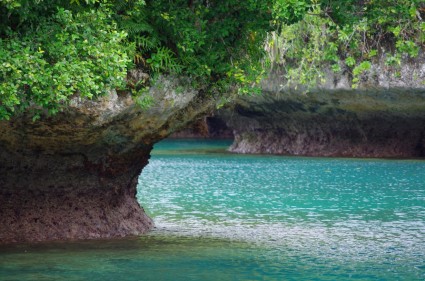
One of the reasons we went to Palau in the first place, well off the cruiser’s beaten track, was to volunteer our boat for Palau’s first marine mammal survey that took place in February, as one of the first major steps in support of their newly created marine mammal sanctuary. We got involved through our dear friend Saras Clere’s sister and brother-in-law’s non-profit organization, Whales Alive. The project was run by the wonderful marine scientist, Olive Andrews, with a research team. It was really interesting, a lot of work, and a ton of fun, to make a long story short. The long story should be taking the form of another short video coming to you soon…ish.
Once the marine mammal survey project was finished, we prepared Endless Summer as quickly as we could for the next leg of our journey—sailing 1000 miles south through eastern Indonesia to Darwin, Australia.
Once the marine mammal survey project was finished, we prepared Endless Summer as quickly as we could for the next leg of our journey—sailing 1000 miles south through eastern Indonesia to Darwin, Australia.
Palau 4 of 5
12 March 2012 | Palau
Manjula
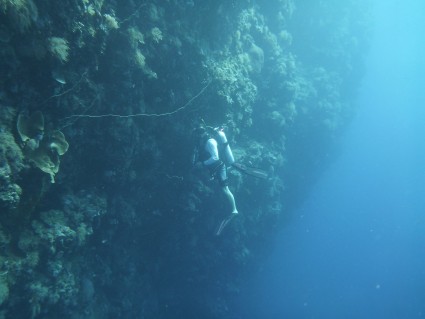
One of the reasons Palau is so well known is for the health, abundance, and diversity of its corals, and tremendous biodiversity of its fish. It also has a large population of manta rays and sharks, sharks, and more sharks. It is a shark sanctuary, in fact. We were particularly blessed by the weather gods when Kurt was with us, with sunshine every day and gorgeous clear water. One major highlight was on a dive off of the southern reef of Peleliu, a famous WWII site, where we had a close up encounter at a depth of 80 feet with a Whale Shark. I’m not sure what was a bigger highlight- seeing that huge and magnificent creature swim past us or hearing the excitement of our Japanese dive guide yelling “WHALE SHARK! WHALE SHARK!” with his great accent (‘Where Shock!’) to everyone he saw on shore afterwards. Apparently Whale Sharks are only spotted a couple of times a year in the whole Palauan archipelago and he had never seen one in his five years of being a dive guide. So Kurt brought some magic with him and we were sorry to see him leave!
Palau 3 1/2 of 5
12 March 2012 | Palau
Manjula
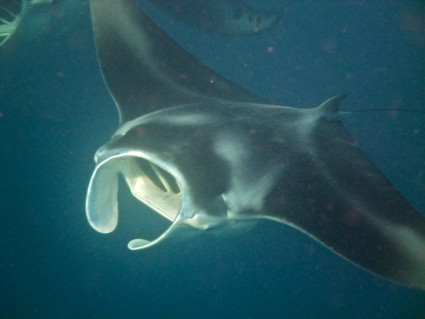
.
Palau 3 of 5
12 March 2012 | Palau
Manjula
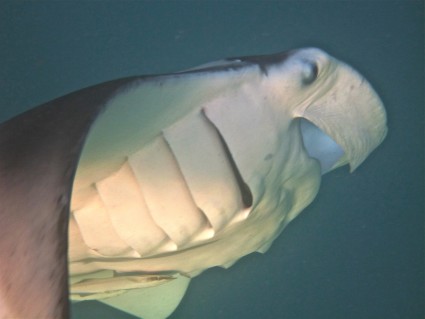
Palau's claim to fame is its incredible marine life.
They have been forerunners in marine conservation and it has paid off.
Of all of the tropical waters we have had the good fortune to explore to date-and that's a lot- Palau's have been the richest and most beautiful. The snorkeling with Keith and Karen was fantastic and it really whet my appetite for scuba diving. I was able to get certified in December, so when our next guest came in January, (that infamous repeat offender, Kurt Frederick) the three of us did a lot of truly spectacular diving.
They have been forerunners in marine conservation and it has paid off.
Of all of the tropical waters we have had the good fortune to explore to date-and that's a lot- Palau's have been the richest and most beautiful. The snorkeling with Keith and Karen was fantastic and it really whet my appetite for scuba diving. I was able to get certified in December, so when our next guest came in January, (that infamous repeat offender, Kurt Frederick) the three of us did a lot of truly spectacular diving.
| Vessel Name: | Endless Summer |
| Vessel Make/Model: | F-41 sailing catamaran |
| Hailing Port: | San Francisco, California |
| Crew: | Steve May and Manjula Dean |
| About: | |
| Extra: |
Australia to Indonesia 2011
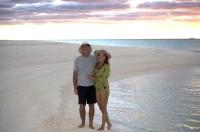
Who: Steve May and Manjula Dean
Port: San Francisco, California
Here is our current location
Favorites
- Papua New Guinea Video
- 21 DAYS TO THE SOUTH PACIFIC, (SHORT FILM)
- Invitation to share our adventure (TRAILER)
- Tanna Island Rescue video (SHORT FILM)
- Tahiti Morea Sailboat Race (SHORT FILM)
- Monterey Bay Aquarium (Educate yourself)
- Ocean Conservancy (Get Involved)
- FishWise (Sustainable Fish Choices)
- Whale study and conservation








